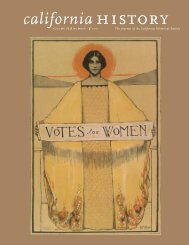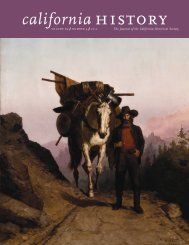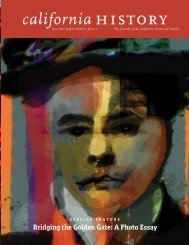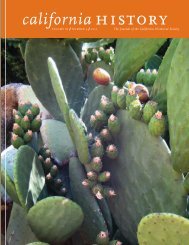Volume 90, Number 1 - California Historical Society
Volume 90, Number 1 - California Historical Society
Volume 90, Number 1 - California Historical Society
Create successful ePaper yourself
Turn your PDF publications into a flip-book with our unique Google optimized e-Paper software.
91; D. Fairchild Ruggles, “Representation<br />
and Identity in Medieval Spain: Beatus<br />
Manuscripts and the Mud jar Churches of<br />
Teruel,” in Languages of Power in Islamic<br />
Spain, ed. Ross Brann, (Bethesda, Maryland:<br />
CDL Press, 1997), 99–12, esp.103.<br />
Ruggles even speculates that the Christian<br />
kings used Islamic ornamentation to create<br />
a Spanish “identity” and reject French<br />
influence. Cisneros quoted in R. Brooks<br />
Jeffrey, “From Azulejos to Zaguanes: The<br />
Islamic Legacy in the Built Environment of<br />
Hispano-America,” Journal of the Southwest<br />
45 (Spring-Summer 2003): 289–327. The<br />
exact quotation reads, “They lack our faith,<br />
but we lack their works.”<br />
39<br />
Elena Lourie, “A <strong>Society</strong> Organized for<br />
War: Medieval Spain,” Past and Present 35<br />
(Dec. 1966): 54–76, esp. 67–8.<br />
40<br />
Qur’an, 8:9<br />
41<br />
Adolf, “Christendom and Islam in the<br />
Middle Ages,” esp. 107–9. Also see Javier<br />
Domínguez García, “Santiago Mataindios:<br />
La continuación de un discurso medieval en<br />
la Nueve España,” Nueva Revista de Filología<br />
Hispánica, 54, no. 1 (2006): 33–56 (41).<br />
42<br />
Luce López-Baralt, Islam in Spanish Literature:<br />
From the Middle Ages to the Present<br />
(Leiden, Netherlands: E. J. Brill 1992), 25.<br />
43<br />
Elena Lourie discusses, and dismisses,<br />
the possibility that the Knights Templar<br />
inspired the rise of Spain’s military societies.<br />
See “The Confraternity,” 159–70.<br />
44<br />
Matthew 5–7; Mark 12:17; John 18:36.<br />
45<br />
Jay Rubenstein, Armies of Heaven: The<br />
First Crusade and the Quest for Apocalypse<br />
(New York: Basic Books, 2011), 24.<br />
46<br />
Lourie, “The Confraternity,” 164n.23.<br />
47 Alfred L. Kroeber, “Stimulus Diffusion,”<br />
American Anthropologist 42, no. 1 (Jan.–Mar.,<br />
1940): 1–20, esp. 1–2, 20. Also consult Lourie,<br />
“The Confraternity,” 163–64; Thomas<br />
Glick and Oriol Pi-Sunyer, “Acculturation as<br />
an Explanatory Concept in Spanish History,”<br />
Comparative Studies in <strong>Society</strong> and History<br />
11, no. 2 (1969): 136–54, esp. 151–52; Glick,<br />
“Muhtasib and Mustasaf: A Case Study of<br />
Institutional Diffusion,” Viator 2 (1971):<br />
59–81; and Dodds, Menocal, and Babale,<br />
The Arts of Intimacy, esp.130–31. All references<br />
to Kroeber will draw on these other<br />
works that use his ideas to discuss the<br />
spread of Muslim ideas to Christians.<br />
48<br />
For one more view on the matter, see<br />
Andrew Wheatcroft, Infidels: A History of the<br />
Conflict Between Christendom and Islam (New<br />
York: Random House, 2003), chapter 3,<br />
eBook, http://books.google.com/books?id=p<br />
2QM1fKXOggC&printsec=frontcover&<br />
source=gbs_ge_summary_r&cad=0#v=onep<br />
age&q&f=false.<br />
49<br />
Qur’an 4:74: “Let those who fight in the<br />
way of Allah who sell the life of this world<br />
for the other. Whoever fights in the way<br />
of Allah, and he is slain, or is victorious,<br />
on him We shall bestow a vast reward.”<br />
Muwatta, Verse 21.15.34 emphasizes the<br />
rewards awaiting the warrior who sacrifices<br />
himself during wartime: “Being slain is but<br />
one way of meeting death, and the martyr<br />
is the one who gives himself, expectant of<br />
reward from Allah.”<br />
50<br />
St. Bernard, “”De Laudibus Novae Militiae”<br />
or “In Praise of the New Knighthood,”<br />
http://webpages.charter.net/sn9/notebooks/<br />
bernard.html.<br />
51<br />
Zamanin, supposedly citing a hadith<br />
(teaching of Muhammad), in Marín, “La<br />
práctica del ribat en al-Andalus,” esp. 197;<br />
Rubenstein, Armies of Heaven, 24.<br />
52<br />
Rubenstein, Armies of Heaven, 24.<br />
53<br />
Ibid., 23–25. For more on the example<br />
of ribat, see Lourie, “The Confraternity,”<br />
167–68, 174.<br />
54<br />
See Roberto Marín Guzmán, “Jihad vs.<br />
Cruzada en al-Andalus: La Reconquista<br />
española como ideología a partir del siglo<br />
XI y sus proyecciones en la colonización de<br />
América, Revista de Historia de América no.<br />
131 (Jul.–Dec., 2002): 9–65.<br />
55<br />
Lourie, “The Confraternity,” 167.<br />
56<br />
Ibid., 165–66, 169.<br />
57<br />
Canon 10, The First Lateran Council,<br />
http://www.papalencyclicals.net/Councils/<br />
ecumo9/htm.<br />
58<br />
Cited in Angus MacKay, “Religion, Culture<br />
and Ideology on the Late Medieval<br />
Castilian-Granadan Frontier,” Medieval Frontier<br />
Societies, ed. Robert Bartlett and Angus<br />
MacKay (Oxford: Clarendon Press 1989),<br />
229.<br />
59<br />
Some scholars say the struggle against<br />
the Muslims had nothing to do with the<br />
conquest of the Americas. See Charles<br />
Gibson, “Reconquista and Conquista,” in<br />
Homage to Irving A. Leonard: Essays on Hispanic<br />
Art, History and Literature, ed. Raquel<br />
Chang-Rodríguez and Donald A. Yates (East<br />
Lansing: Michigan State University, 1977),<br />
19–28.<br />
60<br />
Miguel Asín Palacios, Islam and the Divine<br />
Comedy, tr. and ed. Harold Sutherland (London:<br />
Frank Cass and Co., Ltd., 1968 [1926]),<br />
243n.1.<br />
61<br />
Lourie, “A <strong>Society</strong> Organized for War,” 67.<br />
62<br />
Castro, The Structure of Spanish History,<br />
205.<br />
63<br />
George Kubler, “Mexican Urbanism in the<br />
Sixteenth Century,” The Art Bulletin 24, no.<br />
2 (June 1942): 160–71, esp. 166–68; T. B.<br />
Irving, “Arab Craftsmanship in Spain and<br />
America,” The Arab World 15 (Sept. 1969):<br />
18–26, esp. 25. Also consult Manuel Toussaint,<br />
Arte Mudéjar en America (Mexico, D.<br />
F: Editorial Porrua, 1946), 26.<br />
64<br />
The quotation comes from a letter cited<br />
by Palóu. Father Francisco García Figueroa<br />
and Father Manuel Camino to Father Francisco<br />
Palóu, March 12, 1787, in Francisco<br />
Palóu, <strong>Historical</strong> Account of the Life and Apostolic<br />
Labors of the Venerable Father Junípero<br />
Serra, ed. George Wharton James, trans. C.<br />
Scott Williams (Pasadena: George Wharton<br />
James, 1913), xxix–xxxi.<br />
65<br />
Francisco López de Gómara, The Life<br />
of the Conqueror by His Secretary, ed. and<br />
trans., Lesley Byrd Simpson (Berkeley: University<br />
of <strong>California</strong> Press, 1964), 113–14.<br />
66<br />
Cited in D. A. Brading, Prophecy and Myth<br />
in Mexican History (Cambridge: Cambridge<br />
University Press, 1984), 11.<br />
67<br />
Cited in Herbert Bolton, “The Mission<br />
as a Frontier Institution in the Spanish-<br />
American Colonies,” The American <strong>Historical</strong><br />
Review 23, no. 1 (Oct. 1917): 42–61.<br />
68<br />
Fray Isidro Felix de Espinosa, Crónica de<br />
los colegios de propaganda fide de la Nueva<br />
España (México, 1746), ed. Lino G. Canedo,<br />
O.F.M. (Washington, DC: American Academy<br />
of Franciscan History, 1964), frontispiece.<br />
The quotation is attributed to José<br />
Mariano Beristain de Souza, Biblioteca Hispano-Americano<br />
Septentrional (México, 1816).<br />
69<br />
Hugh Hamill, The Hidalgo Revolt (Gainesville:<br />
University of Florida Press, 1966),<br />
122–23.<br />
70<br />
D.A. Brading, The First America: The<br />
Spanish Monarchy, Creole Patriots, and the<br />
Liberal State (Cambridge: Cambridge University<br />
Press, 1991), 578–81.<br />
65









